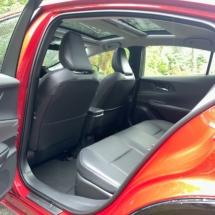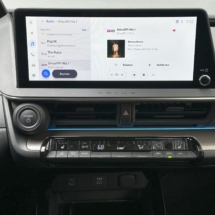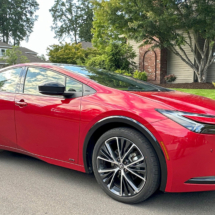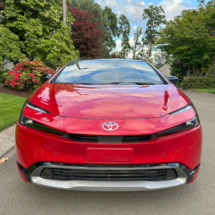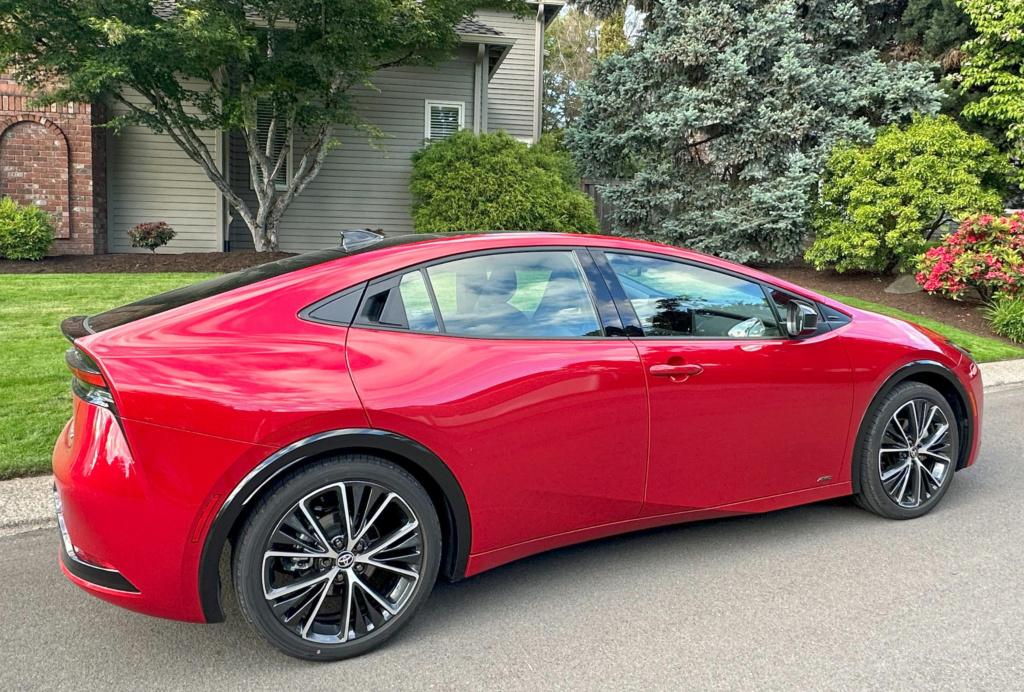
“That’s a Prius?” I heard that several times while test driving the 2024 Toyota Prius XLE. No doubt, the Prius is more attractive than it used to be. Plus it handles better than the Prius of old, is available with all-wheel drive, and has plenty of cargo space. But the Prius still gets great fuel economy, which has always been a top selling point. Drawbacks are a meh interior and a tight second row.
Base Price: $32,495
As Tested: $36,687
Horsepower: 196
Mileage: 49 mpg city/50 mpg highway/49 mpg combined
The Prius was launched in North America in 2000 and became the first mass-produced hybrid. It’s now in its fourth generation. The Prius was redesigned for the 2023 model year and gets no major changes for 2024.
The 2024 Prius comes in three trims: LE, XLE and Limited. Starting prices range from $27,650 to $36,365. Front-wheel drive is standard and all-wheel drive is available on all trims. There’s room for five passengers in two rows of seating.
There are two powertrains. Front-wheel drive models have a 2.0-liter four-cylinder engine and an electric motor with a combined output of 194 horsepower and 139 pound-feet of torque. All-wheel-drive models get the same engine with two electric motors and gain 2 horsepower for a total of 196 hp and 139 pound-feet. The transmission is a continuously variable automatic.
Both powertrains make for decent driving dynamics. While the Prius isn’t exactly sporty, it’s definitely more nimble than older models. Acceleration is respectable from a stop and there’s enough power for merging and passing at freeway speeds. The CVT is smooth. Steering is rather numb but responsive and the Prius corners well. The brakes have a normal feel, unlike the squishiness of some hybrids. The ride is mostly smooth with the suspension absorbing most bumps. The available AWD means you’re ready for varying road conditions. All in all, the Prius is pleasant to drive, whether you’re commuting in town or heading out on a road trip.
Fuel efficiency is excellent for a hybrid car. EPA ratings for my AWD tester are 40 mpg city and 50 mpg highway with a combined rating of 49 mpg. I got 48 during my week with a mix of city and highway driving.
The interior is pleasant but not as upscale as many rivals. There are plenty of hard plastics and some of the materials feel cheap. On the plus side, front seats are comfortable, supportive and roomy with plenty of leg- and headroom for taller adults. An attractive infotainment system dominates the dash. The second row is fine for kids but the sloping roofline cuts into headroom for adults.
Standard features include push-button start, rearview camera, automatic climate control, fabric-trimmed front seats, six-way manually adjustable front seats, seven-inch digital gauge cluster, infotainment system with eight-inch touchscreen, six-speaker audio system, satellite radio, wireless Android Auto and Apple CarPlay, Bluetooth, six USB ports, Wi-Fi hot spot, and automatic high-beam headlights
Available features include remote keyless entry, surround-view camera system, auto-dimming rearview mirror, rear-camera mirror, synthetic leather upholstery, eight-way power-adjustable driver’s seat with power lumbar, driver memory seat with two settings, heated and ventilated front seats, heated steering wheel, heated rear seats, infotainment system with 12.3-inch touchscreen, navigation, eight-speaker JBL audio system, wireless device charging, universal garage door opener, a fixed-glass roof, rain-sensing windshield wipers, and a digital key (you can use your smartphone to lock, unlock and start the vehicle).
Standard driver assistance technologies include forward collision warning, forward automatic emergency braking, adaptive cruise control, lane-departure warning, lane-keep assist, lane-trace assist, blind-spot monitoring, traffic-sign recognition, pedestrian and cyclist detection, rear cross-traffic alert, vehicle exit warning (alerts those exiting the vehicle of other vehicles approaching from behind), and rear-seat alert.
Available driver assistance technologies include reverse collision warning, reverse automatic emergency braking, front and rear parking sensors, and park assist.
The infotainment system looks great with its modern graphics. It’s user-friendly with sensibly arranged menus. The system responds quickly to touch and voice commands, and physical buttons and knobs make it easy to adjust audio and climate settings. Wireless Android Auto and Apple CarPlay are standard.
The 2024 Prius doesn’t have as much cargo space as previous models but there’s still plenty of room. There are 23.8 cubic feet in the LE models, and 20.3 cubes in the XLE and Limited trims. The rear seats fold down to accommodate large and/or bulky items. A cargo area tonneau cover is standard. A power liftgate is available.
The good:
Great fuel efficiency
Handsome looks
Decent driving dynamics
Many standard features
User-friendly infotainment system
Standard wireless Android Auto and Apple CarPlay
Good cargo space
The not-so-good:
Cabin not as upscale as some rivals
Tight second row
Pricing info:
My tester starts at $32,495. The 12.3-inch audio multimedia display is $735. Special color is $425. Fixed glass roof is $1,000. Alloy wheel locks are $80. Door edge guards are $155. Door sill protectors are $250. The Preferred Accessory Package is $452 and includes carpet mats, cargo net, carpet cargo mat, carpet floormats, first aid kit, and rear bumper applique. Delivery fee is $1,095 bringing the grand total to $36,687.
Bottom line:
The Toyota Prius was once known for being a rather ugly car that wasn’t fun to drive – the big plus was its excellent fuel economy. The 2024 Prius has handsome looks, decent performance, lots of cargo space and, of course, great gas mileage. While the cabin isn’t as upscale as some rivals and the second row is tight, the Prius is sure worth checking out if you’re shopping for a hybrid.








